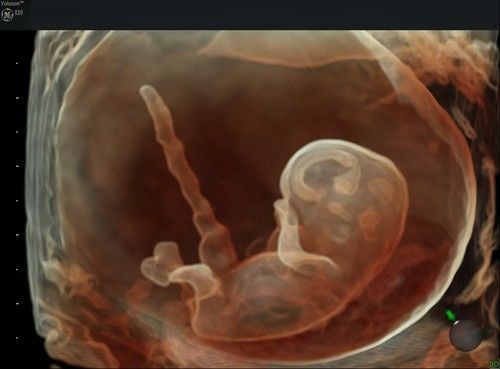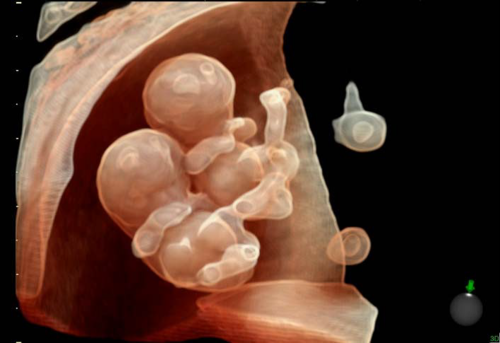4D Ultrasound: GE’s Voluson E10 Ultrasound Machine Gives Us Never-Before-Seen 4D Color Images Of Fetal Development

Today sonograms can make out even the smallest facial detail of the unborn child. One would think things couldn’t get any clearer. Well, think again. The E10 Ultrasound plans on adding one additional, yet crucial, element to the image of your unborn child: color. The only catch, such as with most things in life, is that this additional element is only available for an additional price.
The E10 Ultrasound, designed by GE Healthcare, is truly the future of prenatal care. It’s not just color that this amazing machine can show; it’s able to reveal more about life in the womb than any medical device before it, the NY Daily News reported. “In the past, you could see a flat, two-dimensional image of the fetal profile,” Barbara Del Prince, a global managing director for ultrasound products at GE Healthcare, explained to GE Reports. “But today you can watch their movements in 3D, see a smile or a grimace, glimpse their personality.” According to Medgadget, the Voluson E10 will also have four times the ultrasound pathway, 10 times the data transfer for more speed and higher resolution, and four times the processing power for more flexibility with advanced applications.

More importantly, the ultrasound not only gives parents a preview of their child’s personality; it can also give doctors important information about the child’s health. For example, the E10 Ultrasound can give an accurate picture of veins and arteries, allowing doctors to monitor a child’s brain and heart development from as early as the first trimester. "It may help doctors to make confident diagnoses sooner,” Del Prince said. Although the Voluson E10 is available for use in all patients, Del Prince told Medical Daily in an email that the device is especially useful in high-risk patients. "With these patients, physicians are looking for images to answer specific questions and to provide confidence in the diagnosis. The advanced features such as Electronic 4D imaging are a great benefit in these high risk cases."

Although ultrasound machines, also called sonograms, are most commonly associated with helping pregnant mothers get a glimpse at their unborn children, in reality, the device can actually create images of virtually any organ in the body. The device acts similarly to the bat and dolphin sense of echolocation. It sends out high-frequency waves that reflect off body structure. The computer then translates these waves into an identifiable image for the ultrasound technician. Del Prince told Medical Daily that for ultrasound technicians, the transition from using traditional machines to the E10 will be quite smooth. "Tools like electronic 4D will have a small learning curve. However, most of this will be based on the innovative ways our customers use our products. Once the technology is in clinicians' hands we see that there are many different ways the technology can be used for diagnosis," she wrote.
What makes the ultrasound so unique is that unlike the x-ray machine or the CT scan, there are no dangers of radiation exposure after using the device. Ultrasound machines were recently recognized for their effectiveness in initial diagnosis of kidney stones. "It doesn't necessarily say patients should not get a CT scan, but I think the main message is that an ultrasound is the best place to start," Dr. Charles Scales of Duke University Medical Center in Durham told Reuters in reference to ultrasounds for kidney stone detection.




























